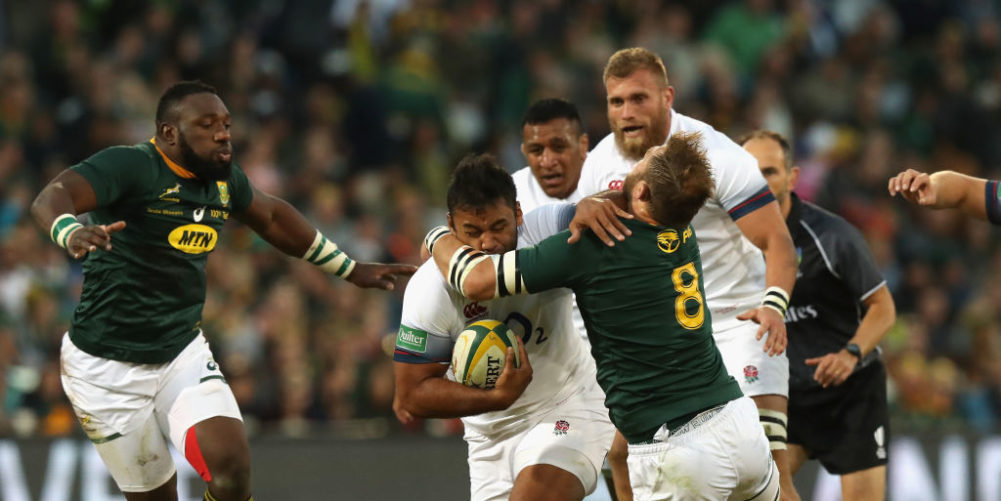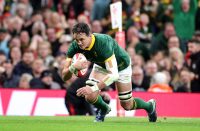By Nick Cain
IT is no surprise that England’s five Test crash, and some of the close-call wins that preceded it, have coincided with Billy Vunipola’s run of injuries since Eddie Jones’ and his team whitewashed Australia two summers ago.
On that tour the heavy-duty Saracens No.8 was world class, capping a series in which he was the dominant forward on the pitch with an unstoppable No.8 pick-and-go try on the blindside in the last minutes of the final Test against the Wallabies.
It was hoped that Big Billy would get into his stride properly after returning to action in April after four months on the sidelines with a broken right forearm. Instead, after his bid to regain full match fitness in the build-up to the tour of South Africa was interrupted by a hamstring tweak from kicking an Aussie Rules ball, he eventually came back as England’s starting No.8 in Johannesburg.
After making a few inroads against the Springboks in Bloemfontein the injury curse struck again when he was replaced just before half-time after refracturing the same forearm. Vunipola had been given a protective foam casing to protect the injury, but he admitted he had discarded it because it carried the psychological connotation he was still not fit to play.
That’s easy to understand, and it’s also unlikely the foam would have given the arm the necessary protection it required in any case. However, another few months on the sidelines is a bitter blow to the No.8, and also to England’s 2019 World Cup plans.
One of the attendant issues facing Eddie Jones around a position that is such a tactical fulcrum is that Vunipola’s understudy, Nathan Hughes, is also injury-prone. The Wasps No.8 was out of action for a good part of the season, and when he was picked by Jones for the Six Nations loss to Scotland he was clearly not match-fit, and soon sustained another injury.
This time last year when Billy Vunipola had to withdraw from the Lions tour due to a shoulder injury I said in this column that the Lions had to get over losing such a talisman in double quick time, and look at the positives rather than being defeatist.
The reality is that key players are always being injured, and there is rarely a good time for it to happen. Just as Warren Gatland got on with getting the best out of Taulupe Faletau at No.8 for the Lions, so Jones must do with England.
Of course, a fully fit Billy Vunipola will be a huge bonus for England’s World Cup campaign, but given the frequency with which he has been injured in the last two years there is no way that Jones can count on him being in mint condition. Furthermore, Hughes is in similar territory.
That means Jones has to reshape his back row so that he has a full-speed contingency in place to win the World Cup without them. My belief is that he has the players to do it, but he must get cracking – although on the South Africa tour it has been difficult to detect a strategy.

If England are going to have a relatively small openside they cannot afford a small No.8 like Sam Simmonds, mainly because the front five is not powerful enough to afford him. That’s why Simmonds should be competing with Tom Curry and Sam Underhill at openside – and I would throw another into the mix in Guy Thompson, who has joined Leicester from Wasps.
It also requires England to have big, powerful men at No.8 and blindside. Brad Shields is a handy option in both positions having played there for the Hurricanes, and the same applies to Don Armand who has played across the back row for Exeter and is one of the best line-out forwards in the Premiership.
There are three other options. Saracens blindside Michael Rhodes has just become residency qualified and has said he wants to opt for England.
Exeter’s Dave Ewers is a tank of a blindside and should come into the reckoning if he finds his feet after injury, and Newcastle‘s Mark Wilson is a gritty, consistent operator who can play 6 or 8.
Jones needs more physical clout in his back row, and he has some sifting to do, but he cannot say he has no options should Big Billy be unavailable.
The Rugby Paper is on sale all year round! Keep abreast of the June internationals and your club’s activities in the off-season by subscribing: http://bit.ly/TRP-Sub
























